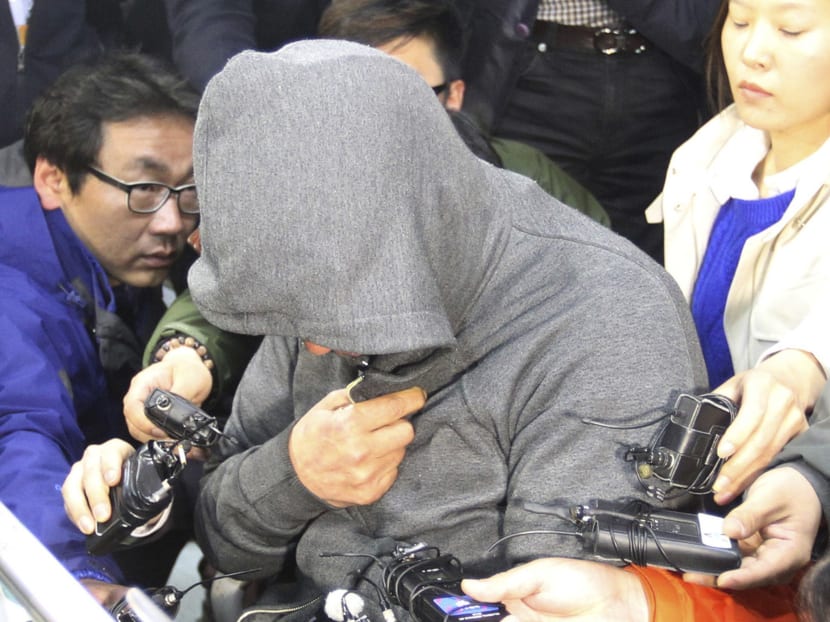Captain, crew accused of abandoning sinking ferry
TOKYO — The parents of hundreds of children missing after yesterday’s (April 16) ferry accident off the coast of South Korea have accused the captain of the vessel of abandoning passengers after it emerged that he and six other crew members were among the first to leave the ship after it started to sink.

Lee Joon-Seok, centre, captain of the South Korean ferry "Sewol" which sank at sea off Jindo, is investigated at Mokpo police station in Mokpo April 17, 2014. Photo: Reuters
TOKYO — The parents of hundreds of children missing after yesterday’s (April 16) ferry accident off the coast of South Korea have accused the captain of the vessel of abandoning passengers after it emerged that he and six other crew members were among the first to leave the ship after it started to sink.
The captain, Mr Lee Joon-seok, who is reportedly in his 60s, escaped from the 6,835-ton Sewol at about 9:30am on Wednesday, just 40 minutes after the vessel apparently ran aground and started to list severely.
Survivors and the families of 287 people, most of them teenagers, who are thought to be trapped inside the sunken vessel directed their anger towards Mr Lee, according to South Korean media reports, as rescue efforts continued in the dim hope that some of the missing passengers might still be alive.
Local officials said 287 people remained unaccounted for more than a day after the vessel, with 475 on board, quickly sank in what may be South Korea’s worst ferry disaster for two decades. Nine people, including four 17-year-old high school pupils and a teacher, are known to have died, while 179 have been confirmed safe, including most of the 30 crew members, South Korean media said.
Distraught parents who travelled to the southern island of Jindo to be near the scene of the accident reacted angrily to reports that the ship’s passengers, including 325 pupils from Danwon high school in the Seoul suburb of Ansan, had initially been told to stay in their cabins rather than head to the emergency exits.
A crew member said an evacuation order had been issued 30 minutes after the accident, but several survivors said they did not hear any instructions to abandon ship. There was speculation that the order was not relayed to passengers on the public address system.
Some relatives threw water at the South Korean prime minister, Mr Chung Hong-won, during a visit to the Jindo gymnasium. “How dare you come here with your chin up?” one screamed at him. “Would you respond like this if your own child was in that ship?”
Another blocked Mr Chung’s path as he tried to leave, saying: “Don’t run away, Mr Prime Minister! Please tell us what you’re planning to do.”
A rescued pupil confirmed that passengers had been told to stay in their seats or cabins after the ship struck what may have been an underwater rock and began to list.
“We must have waited 30 to 40 minutes after the crew told us to stay put,” the pupil said. “Then everything tilted over and everyone started screaming and scrambling to get out.”
Another passenger, Mr Koo Bon-hee, said more people might have escaped had there been an immediate evacuation order.
“The rescue wasn’t done well. We were wearing life jackets. We had time,” said Mr Koo, 36, who was on his way to Jeju island — the ship’s intended destination - on a business trip with a colleague.
“If people had jumped into the water ... they could have been rescued. But we were told not to go out.”
But instead of ordering passengers to leave, officers on the bridge were trying to stabilise the vessel, a crew member said.
Mr Lee, his face hidden by a grey hoodie, told reporters at the coastguard offices that he felt “really sorry for the passengers, victims and their families and am deeply ashamed. I don’t know what to say.” He had earlier been criticised after he was seen drying wet banknotes on his bed while being interviewed by journalists.
Mr Kim Jae-in, a coastguard spokesman, said coastguard officials were questioning Ms Lee, but denied earlier reports that the ferry had turned too swiftly when it was supposed to make a slow turn. He also declined to say whether the ferry had strayed from its usual route.
The tragedy was given added poignancy by text messages sent by pupils who are among those thought to be trapped inside the ship. “Sending this in case I may not be able to say this again. Mum, I love you,” said Shin Young-jin.
Kim Woong-ki, a 16-year-old pupil pleaded with his brother to help in a text sent after the ship listed suddenly to one side. “My room is tilting about 45 degrees. My mobile is not working very well,” Kim texted. His brother attempted to reassure him, saying: “So don’t panic and just do whatever you’re told to do. Then you’ll be fine.”
An 18-year-old female pupil identified only as Shin texted her father to tell him not to worry. “I’m wearing a life vest and am with other girls. We’re inside the ship, still in the hallway,” she told him. Her father’s response, urging her to get out, arrived too late.
“Dad, I can’t,” she said in her final message. “The ship is too tilted. The hallway is crowded with so many people.”
The Sewol’s wreckage is in waters just north of Byeongpung island, located about 470km from Seoul.
Navy divers tried to enter the capsized ship more than 10 times today, but were hampered by strong currents and poor visibility.
Three vessels equipped with cranes are due to arrive tomorrow to help with the rescue and salvage the ship. The rescue operation now involves 169 boats, including 26 navy ships, and 29 aircraft, Mr Kang Byung-kyu, the minister for security and public administration, was quoted as saying by Yonhap. THE GUARDIAN






